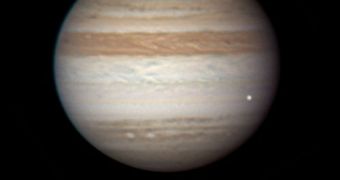About a week ago, on June 3, the gas giant Jupiter was violently impacted by an asteroid. The event was caught on camera by amateur astronomers, who quickly passed the word to their professional peers. Numerous telescopes and space cameras around the world were then brought at the crash site, as experts and laymen alike were waiting to see the debris field caused by the collision. Now, they are still seeing nothing of the sort, Space Fellowship reports, and everyone is curious as to where the space “junk” went.
“It’s as if Jupiter just swallowed the thing whole. [It] was thrilling to see the impact, but the absence of any visible debris has got us scratching our heads,” explain amateur astronomers Anthony Wesley (Australia) and Christopher Go (the Philippines). The team was the first to observe the bright flashes that accompanied the impact at the gas giant. The lack of debris is not something one would expect to see following such a collision. When fragments of the comet Shoemaker-Levy 9 hit the planet back in 1994, the clouds of junk that were generated on the occasion were visible for a long time.
One of the possible explanations for why the debris field is not there could be that the collision never actually happened, some astronomers propose. They argue that the flash of light may have simply been an overgrown Jovian lightning bolt that appeared blown out of proportions. But others disagree. “I consider that very, very unlikely. NASA spacecraft have seen lightning on Jupiter many times before, but only on the planet’s nightside. This dayside event would have to be unimaginably more powerful than any previous bolt we’ve seen. Even Jupiter doesn’t produce lightning that big,” says Glenn Orton, who is a planetary scientist at the NASA Jet Propulsion Laboratory (JPL) in Pasadena, California.
“We’ve seen things hit Jupiter before, and the flash of impact has always been followed by some kind of debris,” the expert adds. “The flash came from an altitude above any cirrus layer, so the debris should be plainly visible – if there is any,” Orton says, explaining that the luminous event was observed in the middle of the gas giant's South Equatorial Belt (SEB). This wouldn't be anything unusual in itself, if it weren't for the fact that the formation itself disappeared earlier this year. Astronomers are currently investigating a possible correlation between the phenomena.
But the new observations carry other implications as well, in terms of planetary security. “Jupiter is getting hit more than we expected. Back in the days of Shoemaker-Levy 9 (SL-9), we calculated that we should see an impact on Jupiter once every hundred years or so. We considered ourselves extraordinarily lucky to witness the SL-9 event. But look where we are now. Anthony Wesley has observed two impacts within the past 12 months alone. It’s time to revise our impact models [particularly for small impactors],” says the JPL near-Earth Object (NEO) program manager, Don Yeomans. This increased impact frequency could also have implications for Earth's safety, although the exact extent of the threat has yet to be determined.

 14 DAY TRIAL //
14 DAY TRIAL //